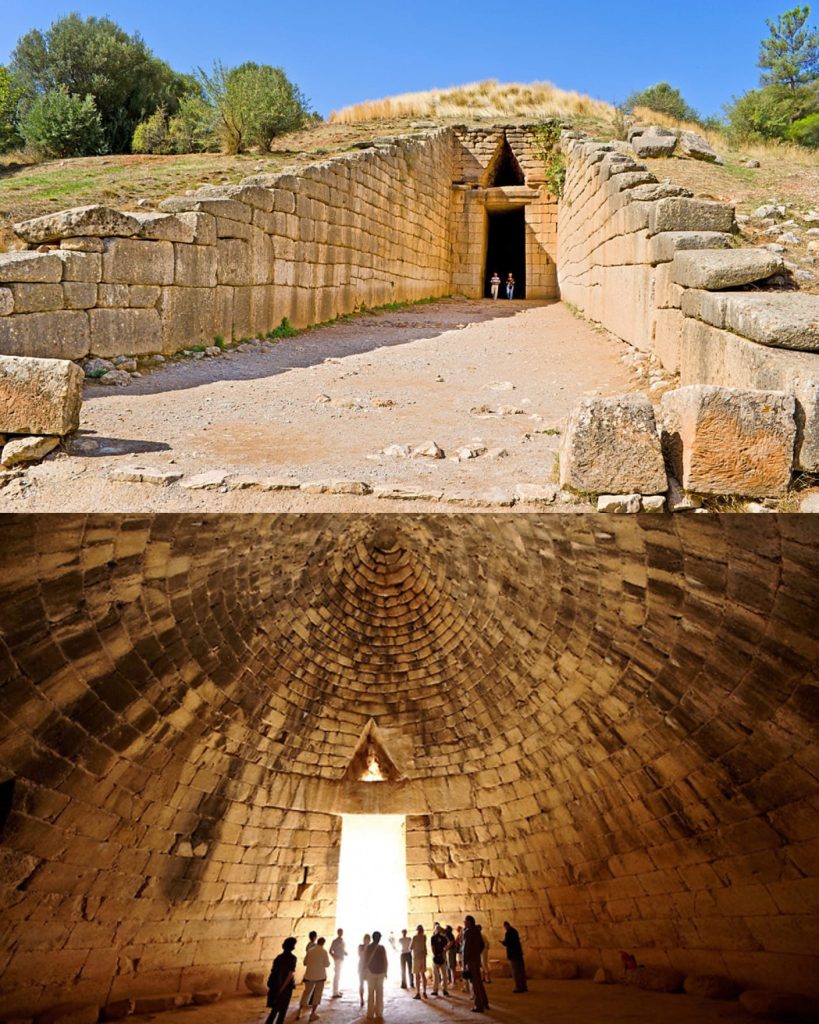Deep within the ancient city of Mycenae, now recognized as a UNESCO World Heritage Site, stands one of the most awe-inspiring architectural achievements of ancient Greece—the Treasury of Atreus. Often referred to as the Tomb of Agamemnon, this majestic structure offers not only a glimpse into the ingenuity of Mycenaean engineering but also a profound connection to the myths, legends, and history that have shaped Western civilization. For centuries, this monumental tomb has fascinated archaeologists, historians, and travelers alike, offering a timeless testament to the creativity and sophistication of a society that flourished over 3,000 years ago.

Approaching the Treasury of Atreus is like stepping back in time to approximately 1250 BC. As you walk along the dromos—a carefully constructed stone-lined passageway that stretches over 36 meters in length—you can almost hear the echoes of ancient footsteps that once trod the same path. The dromos leads to an imposing façade that commands attention. Towering at nearly 5.4 meters, the entrance is framed by massive monolithic door jambs and topped by a vast lintel stone weighing an estimated 120 tons. Above the doorway, a relieving triangle—a key element in ancient engineering—reduces the pressure on the lintel, showcasing the advanced understanding of structural design that Mycenaean builders possessed.
Once inside, visitors are struck by the grandeur of the tomb’s central chamber. This space, known as a tholos or beehive tomb, features a corbelled dome that rises to a staggering 14.5 meters, making it one of the tallest domed spaces constructed in the ancient world until the Roman Pantheon surpassed it over a millennium later. The dome’s precision and symmetry are astonishing, especially considering it was built without the aid of modern tools or mortar. Each stone was meticulously cut and carefully placed to create a seamless, self-supporting structure—a feat of engineering that continues to inspire admiration today.
The walls of the Treasury of Atreus are constructed using ashlar masonry, a technique involving finely cut stones fitted together with exceptional accuracy. This method not only ensured the stability and longevity of the structure but also speaks volumes about the craftsmanship and meticulous attention to detail practiced by Mycenaean artisans. The absence of mortar did not diminish the durability of the tomb; instead, the perfect alignment of the stones has allowed the structure to withstand the passage of time and remain intact for over three millennia.
Despite the magnificence of the Treasury of Atreus, the true identity of the individual buried there remains unknown. Ancient Greek geographer Pausanias, who visited the site centuries later, mentioned the tomb but did not link it to either Atreus or Agamemnon, two legendary kings of Mycenaean lore. Over time, the name “Tomb of Agamemnon” became associated with the site, influenced by the epic tales of Homer and the desire to connect tangible monuments with mythical heroes. While modern scholars believe the tomb likely housed a powerful ruler or noble, its original occupant’s identity has been lost to history, adding to the enduring mystery and allure of the monument.
The 19th century marked a turning point in our understanding of Mycenae and the Treasury of Atreus. Archaeologists, most notably Heinrich Schliemann, began excavating the site, driven by a passion to uncover the truth behind Homer’s epics. Although Schliemann’s work was controversial and often criticized for its methods, it reignited global interest in Mycenaean civilization. Further excavations in the 20th century revealed an array of artifacts—pottery, tools, jewelry—that provided critical insights into the daily life, beliefs, and artistic achievements of the Mycenaeans.
The Treasury of Atreus is more than a burial site—it is a powerful bridge between history and myth, connecting us to a culture that laid the foundations of Western art, literature, and thought. Standing inside its cool, shadowed chamber, one cannot help but imagine the solemn rituals that once took place within its walls. Perhaps the tomb was a site of reverence, a place where family and followers honored their leader with offerings, music, and prayers for a safe journey into the afterlife. Every stone, every chisel mark, tells a story of human hands at work—skilled, purposeful, and driven by a desire to create something that would stand the test of time.
The legacy of the Treasury of Atreus is not confined to its architectural brilliance. It invites us to ponder the values and aspirations of the people who built it. In an age without modern technology, they achieved a level of precision and grandeur that continues to astonish. Their accomplishments remind us of the universal human drive to seek meaning, to honor the dead, and to leave a mark for future generations to discover.
For scholars, the tomb remains a subject of ongoing research, continually offering new insights into Mycenaean society. For travelers, it provides a profound and moving experience—a chance to walk in the footsteps of an ancient civilization and to feel, even briefly, connected to the lives of those who came before. The Treasury of Atreus stands as a monument not only to the past but also to the enduring power of human imagination and creativity. It challenges us to preserve and explore our heritage, and to draw inspiration from the achievements of our ancestors. Through its stone walls and towering dome, it speaks across the centuries, a silent but powerful voice of a civilization that, though long gone, continues to captivate the hearts and minds of people around the world.





